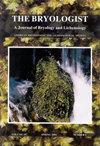Photosynthetic electron transport in a tropical moss Hyophila involuta
IF 1.5
4区 生物学
Q4 PLANT SCIENCES
引用次数: 1
Abstract
Abstract. Despite their global distribution moss physiology is not well understood, particularly in tropical environments. Photosynthetic Electron Transport Rate (ETR) of Hyophila involuta was measured using PAM technology. The plants were growing in a heavily shaded habitat with irregular sunflecks of full sunlight. Two models were used for estimating photosynthetic electron transport (ETR), the Waiting-in-Line and Eilers-Peeters models. Both take photoinhibition into account and gave similar results. The population studied was growing on bricks and stonework and so periodically dried out. The same species is sometimes found in waterfall environments where it is semi-aquatic. ETRmax was low at dawn, increased to an early morning maxima and then decreased during the course of the day, partially reversed by rainstorms. Mid-morning (10:30 solar time): Eopt ≈ 521 ± 77 µmol photon m–2 s–1 which is higher than might be expected in a shaded sun-fleck environment, ETRmax ≈ 28.3 ± 2.5 µmol e- m–2 s–1 on a projected surface area basis or ≈ 57.7 ± 5.1 (µmol e- g–1 Chl a s–1), photosynthetic efficiency (Alpha, α0) ≈ 0.301 (e- photon–1 g–1 Chl a). Chl a content of Hyophila was ≈ 453 mg Chl a m–2 with Chl b/a ≈ 0.371. The O2 electrode-based respiration rate was R = 6.78 ± 0.698 µmol O2 g–1 Chl a s–1, the ETRmax is roughly equivalent to Gross photosynthesis (Pg) ≈ 14.4 ± 1.28 µmol O2 g–1 Chl a s–1 (4 e-/ O2), so the optimum Pg/R ratio is about 2.12 ± 0.289 and net photosynthesis (Pn) is ≈ 7.62 ± 1.46 µmol O2 g–1 Chl a s–1. Thus even under optimum irradiance net photosynthesis was actually rather low. pH experiments showed that Hyophila used both CO2 & HCO3- inorganic carbon sources, suggesting that a concentrating mechanism (CCM) is present. Hyophila is partially homiochlorophyllous, recovering well from desiccation after 2h of lighted rehydration and recovers more after 24h but lost ≈30% of its Chl a. The moss retained its chlorophyll content if desiccated in the dark. The moss lost ≈ 2/3 of its Chl a during the monsoonal dry season.热带苔藓小圆藓的光合电子传递
摘要尽管苔藓在全球分布,但人们对它们的生理机制还不是很了解,特别是在热带环境中。采用PAM技术测定了珙桐的光合电子传递率(ETR)。这些植物生长在阴凉的地方,有不规则的阳光斑。利用排队等候模型和Eilers-Peeters模型估算光合电子传递(ETR)。两者都考虑了光抑制,并给出了相似的结果。所研究的人口是靠砖块和石制品生长的,因此会周期性地干涸。同一物种有时在瀑布环境中被发现,那里是半水生的。ETRmax在黎明时较低,在清晨增加至最大值,然后在一天中减弱,部分被暴雨逆转。上午(太阳时间10:30):Eopt≈521±77µmol photon m-2 s-1,高于遮阳太阳斑环境下的预期值,ETRmax≈28.3±2.5µmol e- m-2 s-1(投影表面积)或≈57.7±5.1(µmol e- g-1 Chl a s-1),光合效率(Alpha, α0)≈0.301 (e- photon - 1 g-1 Chl a)。O2电极呼吸速率R = 6.78±0.698µmol O2 g-1 Chl a s-1, ETRmax大致相当于总光合作用(Pg)≈14.4±1.28µmol O2 g-1 Chl a s-1 (4 e-/ O2),因此最佳Pg/R比值约为2.12±0.289,净光合作用(Pn)≈7.62±1.46µmol O2 g-1 Chl a s-1。因此,即使在最佳辐照度下,净光合作用实际上也相当低。pH实验表明,Hyophila同时使用CO2和HCO3-无机碳源,表明存在浓缩机制(CCM)。苔藓属部分同叶绿素植物,在光照下再水化2h后恢复良好,24h后恢复更多,但Chl a损失约30%。在季风性旱季,苔藓损失了约2/3的Chl a。
本文章由计算机程序翻译,如有差异,请以英文原文为准。
求助全文
约1分钟内获得全文
求助全文
来源期刊

Bryologist
生物-植物科学
CiteScore
2.40
自引率
11.10%
发文量
40
审稿时长
>12 weeks
期刊介绍:
The Bryologist is an international journal devoted to all aspects of bryology and lichenology, and we welcome reviews, research papers and short communications from all members of American Bryological and Lichenological Society (ABLS). We also publish lists of current literature, book reviews and news items about members and event. All back issues of the journal are maintained electronically. The first issue of The Bryologist was published in 1898, with the formation of the Society.
Author instructions are available from the journal website and the manuscript submission site, each of which is listed at the ABLS.org website.
All submissions to the journal are subject to at least two peer reviews, and both the reviews and the identities of reviewers are treated confidentially. Reviewers are asked to acknowledge possible conflicts of interest and to provide strictly objective assessments of the suitability and scholarly merit of the submissions under review.
 求助内容:
求助内容: 应助结果提醒方式:
应助结果提醒方式:


